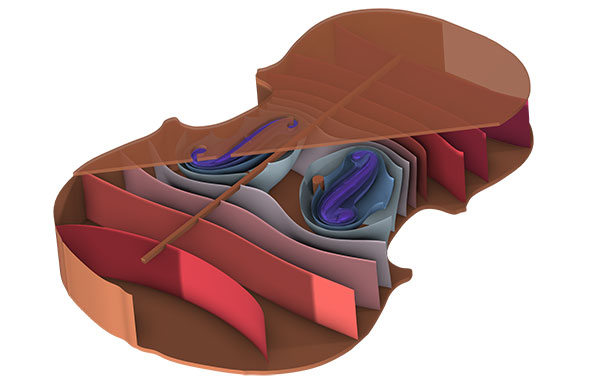
FEA of the standing acoustic pressure wave for the lowest resonant acoustic mode of a violin body. FEA can contribute to understanding an instrument’s timbre by computing resonant modes and frequencies, which serve as an acoustic fingerprint. Images courtesy of COMSOL.
Latest News
October 27, 2022
Kevin Basier is a luthier or maker of stringed instruments such as violins or guitars. He is turning his artistry to the wonderment of engineering design technology. Bassier recently designed and built an acoustic violin that was made using generative design iterations thanks to assistance from engineers at the Autodesk Technology Center in Birmingham, UK.
Though engineering design software solves and perfects many things in the world at large, it is well on its way to making great strides in musical instrument design and engineering the perfect sound.
FEA and CFD for the Perfect Sound
Finite element analysis (FEA) is used successfully to design musical instruments and help designers meet very specific demands in an ongoing effort to create the perfect sound. It is effectively assisting musicians in musical composition.
“FEA has been used for a very long time to analyze vibrating bodies and determine their resonant frequencies,” says Richard Mitchell, senior director of product management with Ansys. “Work in this area started nearly 70 years ago where simplified beam-like models were initially used to study vibration characteristics of aircraft wings and engine blades. Since then, efforts to improve accuracy and fidelity of the models have continued in earnest.”
Mitchell points out that there is a direct relationship between the excitation of a structure and the sound or noise that the structure generates. Ansys customers typically use massive compute resources to better understand vibration characteristics of structural components and to design quieter aircraft engines, electric cars and household appliances like vacuum cleaners.
“Since all musical instruments, including stringed, percussion and wind instruments, rely on excitation and vibration of strings, membranes or resonance of an air column to make musical notes, the same technology to build quieter cars could be used to design musical instruments with highly refined and precise notes,” Mitchell says.
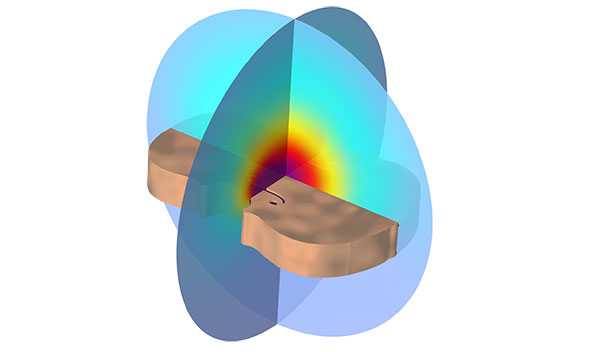
“For example, researchers use Ansys to help musicians refine designs of the sound box in guitars and violins by building simulation models that predict their resonance characteristics accurately,” Mitchell explains. “This is only possible by representing the wood grain in the body of the guitar or violin in an accurate manner. The rich material modeling capabilities allows researchers to present the wood grain direction, layers and the subtle differences in the structural properties of different wood species in a highly accurate manner.”
Dr. Paul Lethbridge is the director-product marketing for SimScale GmbH. Lethbridge is in Portland, OR, while the company is headquartered in Munich, Germany. Lethbridge says FEA and computational fluid dynamics (CFD) can help perfect musical instrument design.
“Both FEA (for structural and thermal simulation) and finite volume method (for fluid flow simulation) have seen quite a lot of application in the design of musical instruments,” says Lethbridge, who notes that many instruments/parts of instruments benefit from simulation.
“Structural vibration analysis can be used to simulate anything that is struck, plucked or bowed,” Lethbridge says. “The simulation provide insight into the frequency of vibration, the mode shapes, low and high order, and can also factor in effects of nonlinear materials (like wood or the membranes used for drums) and also temperature effects (structures tend to expand with increasing temperature, shifting resonant frequencies slightly even over a few degrees change in ambient temperature).”
He adds that researchers can apply CFD to understand air flow velocity and pressure distribution in woodwind and brass instruments, and some tools allow users to understand fluid-structural by coupling the structural and CFD physics bidirectionally, although he notes that this class of simulation is complex and computationally expensive, few people are using it for musical instrument design.
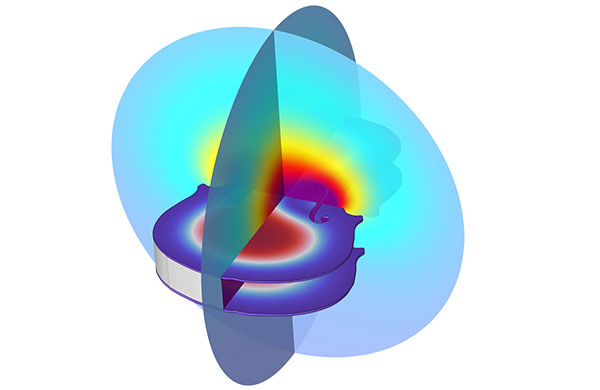
Computing Resonant Modes and Frequencies
Design must incorporate the importance of resonance frequencies, together with other characteristics of sound, says Bjorn Sjodin is VP of product management at COMSOL.
“Depending on how a musician is playing an acoustic musical instrument, for example, a violin by applying powerful or gentle bow strokes, the resonant vibrational modes (vibrational shapes) of an instrument are excited to a varying degree at a discrete set of resonant frequencies,” says Sjodin.
“The set of resonant frequencies together with their relative amplitude determine the timbre, or tone color, of the instrument,” adds Sjodin. “Due to the importance of the resonance frequencies, a useful way in which an FEA can contribute to understanding the timbre of an instrument is to compute the resonant modes and frequencies, also called eigenfrequencies, which in this way serve as a kind of acoustic fingerprint.”
Sjodin notes that FEA of an instrument such as a violin or a guitar may include traditional structural vibrational FEA as well as acoustic FEA of the air volume within and surrounding the instrument. This means that computing the resonant frequencies, traditional structural vibrational FEA of an instrument’s body can be modeled using solid mechanics or structural shells, depending on the material’s thickness.
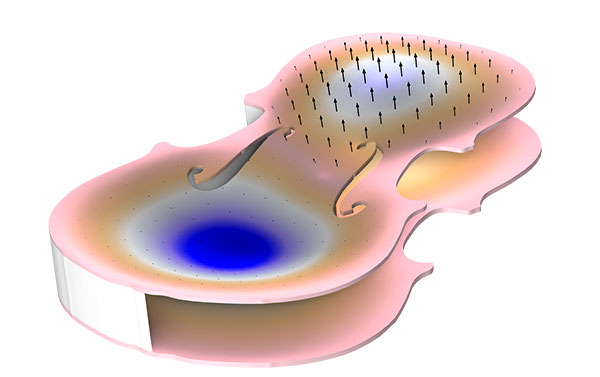
“In this way the resonant modes and frequencies of the structural part of an instrument are found,” he says. “Similarly, the body of air surrounding the instrument will have its set of air-pressure driven resonant modes and frequencies, which can be computed in a way very similar to their structural counterparts using FEA.”
Sjodin explains that an acoustic musical instrument needs to be seen as more than just its structural component. Acoustically speaking, the surrounding body of air is also part of the instrument and will help shape its sound.
The structural body of the instrument is strongly interacting with the air, which affects the structural part with additional mass and inertia, Sjodin continues. So, to accurately predict the resonances of an instrument, a coupled acoustic-structural analysis is necessary. In such a coupled analysis, on one hand, the local structural acceleration of the instrument body will create a pressure wave in the air, and, on the other hand, the local air pressure will exert a pressure force back on the structure.
Sjodin also explains that brass and woodwind instruments design, in addition to string instrument design, employ FEA well.
“Similar to a string instrument, a brass and woodwind instrument may also have a strong interaction between the instrument's structural part and the air column inside the instrument, contributing to its tonal color,” says Sjodin. “FEA can here be used in the same way as for string instruments to predict resonant modes and frequencies.”
Sjodin points out, however, that one challenge when simulating acoustic instruments, is the many ways in which a musician can produce the sound. For example, there are many different techniques for bow strokes with traditional Italian names such as legato, staccato, and portato.
“Accurately representing such sound producing mechanisms can be computationally very time consuming and the friction forces involved can be very complicated to describe,” he says.
Designing the Perfect Sound
Creating the perfect sound often entails more than just focusing on the instrument itself. It’s also about the concert hall or environment where musicians perform. Sjodin says that beyond analyzing the musical instrument itself, FEA analysis can be extended to that surrounding environment and even include the acoustic space of a concert hall.
“Here, FEA is typically used for lower, or bass, frequencies whereas higher frequencies are analyzed by other methods such as ray acoustics methods,” says Sjodin. “In a way, a room or concert hall is in itself a form of musical instrument, but the analysis usually has a different focus.”
As he explains, there is a common analysis task to compute a set of room metrics to determine the room’s reverberation characteristics. Such a room acoustics analysis can give information on the reverberation time, or how “long” the room will make a sound last, as well as the room’s clarity index and definition, which are terms used to describe the interplay between the direct sound that reaches a listener relative to reverberated sound.
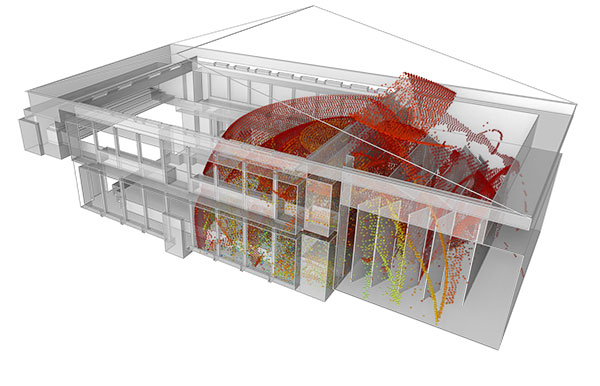
Ansys’ Mitchell looks to the future of musical instrument design as not only employing FEA and other technologies, but also using different materials.
“As technology has advanced and as high-quality wood becomes scarcer, musicians are embracing the once unthinkable idea of using instruments made of composite materials or plastics,” says Mitchell. “Today carbon fiber or graphite composites are widely used to make a variety of instruments. They are more durable, water resistant and impervious to temperature and humidity changes.”
More Ansys Coverage
More Autodesk Coverage
More COMSOL Coverage
More SimScale Coverage

Subscribe to our FREE magazine, FREE email newsletters or both!
Latest News
About the Author
Jim Romeo is a freelance writer based in Chesapeake, VA. Send e-mail about this article to [email protected].
Follow DE






